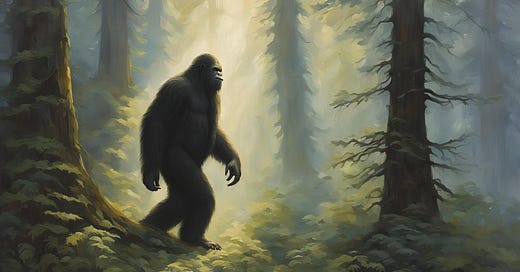The Bigfoot legend has captivated imaginations for generations. From whispered campfire tales to blurry footage and mysterious footprints, the mystery of this elusive creature persists. But what do we really know, and how close are we to uncovering the truth? In this post, we'll delve into the world of Bigfoot, drawing on insights from a recent conversation with Eric Nelson, a retired law enforcement officer and volunteer at the Willow Creek China Flat Museum and Bigfoot Collection, to explore the evidence, the theories, and the enduring allure of this legendary cryptid.
A Creature of Legend and Lore
Bigfoot, also known as Sasquatch, is a purported ape-like creature said to inhabit the forests of North America. Descriptions vary, but generally, it's depicted as a large, hairy, bipedal primate, standing between 6 and 10 feet tall, with a powerful build and large feet. While scientific consensus largely dismisses Bigfoot as a myth, a dedicated community of researchers and enthusiasts continues the search, fueled by anecdotal evidence, eyewitness accounts, and the occasional tantalizing piece of potential proof.
The Evidence: A Tangled Web of Clues
The evidence for Bigfoot's existence is a complex and often contradictory mix. Footprints, casts, and alleged sightings form the core of the evidence, but these are often subject to misinterpretation or outright hoaxes. The Patterson-Gimlin film, a short piece of footage from 1967, remains a focal point of debate, with some arguing it depicts a genuine creature while others claim it's an elaborate hoax. As Eric Nelson points out, "The Patterson-Gimlin film… even attempts to replicate the gait in a lab setting have failed."
Beyond physical evidence, researchers also point to vocalizations, such as the mysterious "Sierra Sounds," and behavioral patterns like the reported construction of woven nests and complex tree structures. "They have found nests in forests and they believe that the nests look like they're woven. So it would have, you know, a posable thumb," Nelson explains. However, these too are open to interpretation, with skeptics often offering alternative explanations.
Theories and Interpretations: A Spectrum of Belief
The Bigfoot community is far from monolithic. Theories about the creature's nature range from it being a flesh-and-blood primate, perhaps a relict hominoid related to humans, to more fringe ideas involving paranormal or supernatural phenomena. Nelson shares his own perspective: "I believe that this thing exists. It has to be more than just a highly adapted predator that's elusive. It's gonna be something that's sentient, that can think and reason… It has to be something that's going to be more than just an ape that's reactionary." He suggests that if Bigfoot exists, it's likely a "relict hominin," a surviving relative on the human family tree.
The Elusive Truth: Why No Body?
One of the biggest obstacles to confirming Bigfoot's existence is the lack of a definitive physical specimen. Why haven't we found a body, or even bones? Nelson acknowledges the common explanations, such as rapid decomposition in acidic forest soils and scavenging by animals, but finds them insufficient. "Right after an avalanche or a tree fall, why haven't we found one in a timely manner?" he asks. The possibility that Bigfoot might bury its dead, a behavior consistent with intelligent creatures, is also considered.
Personal Encounters: Stories from the Heart
Perhaps the most compelling aspect of the Bigfoot phenomenon is the sheer number of personal encounter stories. Nelson, who has spoken with numerous individuals at the Willow Creek museum, shares several accounts, including those from an FBI agent and a primatology expert. He emphasizes the emotional authenticity of these stories, noting the visceral reactions and genuine conviction of the storytellers. "These stories… it connects to you in a different level," Nelson says. "That's part of our extra senses or whatever." While these anecdotes don't constitute scientific proof, they offer a powerful testament to the enduring mystery of Bigfoot and the profound impact of these alleged encounters.
The Future of the Search: Conservation and Ethical Considerations
If Bigfoot's existence is ever confirmed, the next steps would be fraught with complex ethical considerations. Nelson highlights the potential dangers of human intervention, emphasizing the need for conservation and protection. "What did humans means do with new species? We kill them to experiment with them… And either one of those two things aren't in the best interest of an elusive wild creature," he cautions. The question of how to balance scientific curiosity with the well-being of a potentially sentient species would be paramount.
The Allure of the Unknown
Whether you're a believer, a skeptic, or somewhere in between, the Bigfoot legend continues to fascinate. It taps into our primal curiosity about the unknown, our desire to explore the uncharted territories of our world, and our enduring fascination with the mysteries that lie just beyond our understanding. As Eric Nelson suggests, "It's a huge subject… It's kind of a personal journey." The search for Bigfoot is not just a quest for a creature; it's a reflection of our own humanity, our capacity for wonder, and our ongoing pursuit of knowledge.
For the full interview check out the Podcast episode ‘Big Foot’ Here
Or watch it here



